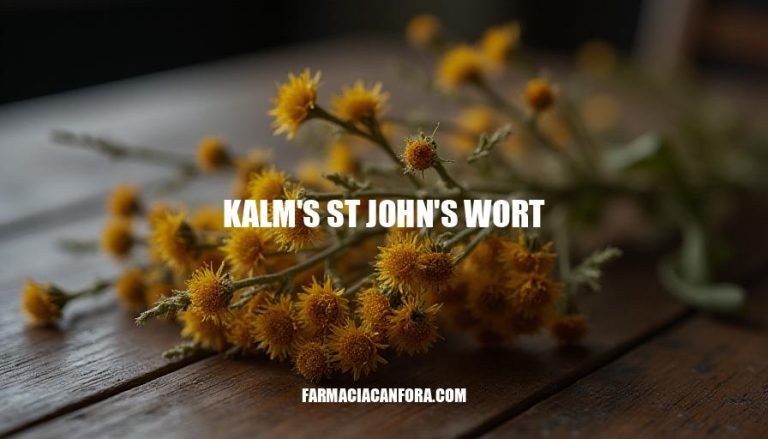


Kalm’s St. John’s Wort is a pretty cool plant that can thrive in tough conditions. It’s a shrub with yellow flowers that grow in the summer and attract bees and butterflies. The leaves are narrow and bluish-green, and it grows up to 1 meter tall.
This plant is native to North America and loves growing in rocky or sandy soil. It helps prevent erosion and provides food for caterpillars and pollinators.
Kalm’s St. John’s Wort, scientifically known as Hypericum perforatum, has been used for centuries for its medicinal properties. The plant contains several active compounds, including hypericin, hyperforin, and flavonoids, which contribute to its therapeutic effects.
Medicinal Properties:
Antidepressant: St. John’s Wort is widely recognized for its antidepressant properties. The active compounds, particularly hypericin and hyperforin, are believed to inhibit the reuptake of neurotransmitters such as serotonin, dopamine, and norepinephrine, which helps improve mood and alleviate symptoms of depression.
Anti-inflammatory: The plant’s essential oils and flavonoids possess anti-inflammatory properties, making it useful in treating conditions such as arthritis and other inflammatory disorders.
Antibacterial and Antiviral: St. John’s Wort has been shown to have antibacterial and antiviral properties, which can help in treating infections and boosting the immune system.
Wound Healing: The herb is known for its ability to promote wound healing.
It has been traditionally used to treat cuts, burns, and bruises due to its astringent and anti-inflammatory properties.
Nerve Pain Relief: St. John’s Wort is sometimes used to relieve nerve pain, such as that associated with sciatica or neuralgia.
Traditional Uses:
Ancient Greece: The origins of St. John’s Wort trace back to ancient Greece, where it was esteemed for its healing properties. The ancient Greeks utilized it for its calming effects, believing it could alleviate symptoms of anxiety and depression.
Medieval Europe: During the Middle Ages, St. John’s Wort was considered to be imbued with magical powers and was used to ward off evil and protect against disease. It was also employed to treat wounds, kidney troubles, and nervous disorders.
Folk Medicine: In various cultures, St. John’s Wort has been used as a natural remedy for mood disorders, nerve pain, and wound healing.
It was often applied topically or taken as an infusion to address these ailments.
Modern Uses:
Depression and Anxiety: St. John’s Wort is commonly used as a natural remedy for mild to moderate depression and anxiety. It is believed to support emotional balance and improve mood without the side effects associated with conventional antidepressants.
Menopause and PMS: The herb is also used to alleviate symptoms of menopause and premenstrual syndrome (PMS), such as mood swings, irritability, and fatigue.
Skin Health: Applied topically, St. John’s Wort can aid in the healing of burns, bruises, and minor wounds due to its anti-inflammatory and astringent properties.
Nerve Pain: Modern herbalists continue to use St. John’s Wort to relieve nerve pain and support nerve healing.
Scientific Studies:
A systematic review of St. John’s Wort for major depressive disorder found that the herb is superior to placebo in improving depression symptoms and not significantly different from antidepressant medication in mild and moderate depression.
Another study published in JAMA compared the efficacy and safety of a standardized extract of St. John’s Wort with placebo in outpatients with major depression. The study concluded that St. John’s Wort was more effective than placebo and had fewer side effects compared to conventional antidepressants.
The National Institutes of Health (NIH) has also reviewed the effectiveness of St. John’s Wort for depression, noting that it may help some types of depression similar to standard prescription antidepressants, but the evidence is not definitive.
St. John’s Wort continues to be a popular herbal remedy for various ailments, supported by both traditional use and modern scientific research.
1draxe.com2www.botanical-online.com3naturalherbals.net4christopherhobbs.com5bhma.info6bing.com7www.healthpub.com8www.herbalreality.com9themedicinalplants.com10systematicreviewsjournal.biomedcentral.com11jamanetwork.com12files.nccih.nih.gov
Kalm’s St. John’s Wort is an important plant species that deserves conservation efforts due to its medicinal properties, ecological value, and cultural significance.
As a native North American plant, it has been used for centuries in traditional medicine to treat various ailments, including depression, anxiety, and nerve pain.
To cultivate Kalm’s St. John’s Wort, one can start by planting seeds or seedlings in well-draining soil with full sun to partial shade.
The plant thrives in rocky or sandy soils and can grow up to 1 meter tall. It is essential to provide the plant with adequate moisture, but make sure not to overwater it.
Kalm’s St. John’s Wort faces several threats to its natural populations, including habitat destruction, overgrazing, and invasive species competition.
Conservation efforts are necessary to protect this valuable plant species and preserve its medicinal properties for future generations.
Protecting and restoring habitats: Efforts should be made to preserve and restore the natural habitats of Kalm’s St. John’s Wort, including rocky outcrops and sandy soils.
Reducing invasive species competition: Invasive species can outcompete native plants like Kalm’s St. John’s Wort for resources such as water and nutrients.
Promoting sustainable land use practices: Sustainable land use practices, such as rotational grazing and permaculture, can help reduce the impact of human activities on Kalm’s St. John’s Wort habitats.
By conserving Kalm’s St. John’s Wort, we can ensure the long-term availability of this valuable plant species for medicinal purposes, ecological benefits, and cultural significance.